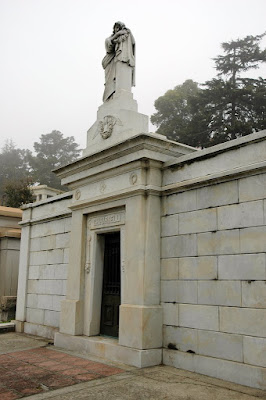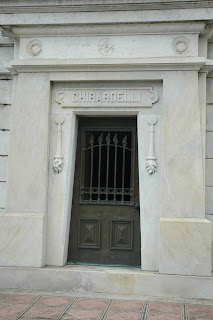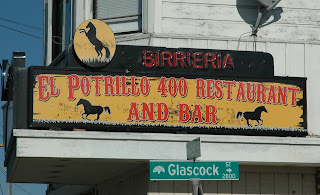This guest post is by Tim Eyre.

Crossroads
Emergency
Housing
bout a month ago, driving farther down International Boulevard than my business usually takes me, an impressive building caught my eye that I'd failed to notice before. What corporation was this sleek building the headquarters for? With its mint green walls and fanciful yellow tower, the
Crossroads Emergency Shelter stands as a beacon of modern architecture and progress in an otherwise hardscrabble neighborhood.
Looking further into the building, I discovered that it opened in 2008 after an $11 million construction effort. That stopped me in my tracks. With all the causes that need funding, why drop such a hefty figure on the homeless? They're not exactly contributing to our tax base, right?
It only took a minute to realize my own ignorance and appreciate the virtues of Crossroads. The East Oakland Community Project's 125-bed building has solar panels on its roof, a brightly colored mural in the lobby (painted by the community), and hydronic heating using grey water to heat the building. If green building is the approach we should be taking with all new construction, a principle that people of all political and philosophical backgrounds mostly agree on, then why not follow suit for the most needy?
Here's how I justified the expense to myself: Imagine you have some insurmountable problem, like having to come up with an extra $5,000 in income this month, doubling your regular salary.
You're going to need to find some other sources of income – probably something creative. That's going to require time and concentration.
Everything else will take the backseat for awhile, right? You need to focus fully on the task at hand.
Now imagine that your room is a wreck, with piles of clothes stacking up on the dresser and dust bunnies under the bed. Your kids are home sick, and someone needs to call the plumber before the kitchen sink backs up again.
With all the distractions constantly around us, it's hard enough to concentrate on a major task until all the other pieces of our daily lives are back in place.
Now imagine that you're starting off with nothing; penniless, with no assets, and you're HIV positive. You're given a bed and a hot meal once a day at the shelter, but you have to get in line early to ensure a spot each night. Your goal is to be self-sufficient, renting a room in an apartment with a steady job, within three months. It seems impossible, and it's easy to give up and turn to the bottle or drugs.
The goal of most shelters is to get the recipients of their care off the streets and back into a productive life. It's a task made more difficult by the environs of most shelters: bleak concrete bunkers with unnatural lighting and prison-like facilities. The dreary surroundings make it easier to give up and fall back into old substance abuse habits.
Crossroads recognizes that in a sunny, light-filled atmosphere of hope, people are more likely to take personal responsibility and stick with a plan to success.
"I wanted to help create an environment where people could wake up and say, 'Okay, things are bad, but I have a clean environment where I can work on my other issues,'" Crossroads executive director Wendy Jackson told Ode Magazine in 2008.
The shelter already boasts tons of success stories.
Former resident Sharon Hicks ended up at Crossroads after suffering from domestic violence and losing her child. An AIDS sufferer, her depression led to drug use. Counselors at the East Oakland Community Project helped Hicks design a money management plan and to regain custody of her daughter. They now live together in an affordable apartment that Crossroads staff helped her find.
Countless other men, single mothers, and families share similar stories, not just at Crossroads but at shelters around the country. The trend that Oakland helped begin has spawned other green shelters around the country. At
The Bridge in Dallas, crime rates in the surrounding community have dropped 18 percent in the three years since the award-winning building opened. Austin, Tex., and Boulder, Col., both boast shelters with amenities their users can take pride in.
A friend even sent me a link to
a new shelter being built by the nonprofit Crisis Ministries in Charleston, SC. Rainwater collection and a silver LEED certification at a homeless shelter in the deep South? As is often the case, what starts in California slow trickles east.
If you haven't been out to Crossroads, I encourage you to
volunteer. They're open to help of all sorts, from serving food in the kitchen to offering computer help. There's really no better way to directly help the needy in your community. Fortunately, for both the homeless and the volunteers, it's much easier to smile and look ahead from a naturally lit green building than the concrete bunker shelters of yesterday.
Tim Eyre works in the self storage industry, regularly traveling to see locations like this Oakland self storage facility near Jack London Square. Tim also contributes to the Extra Space Storage Blog on a regular basis.
































































